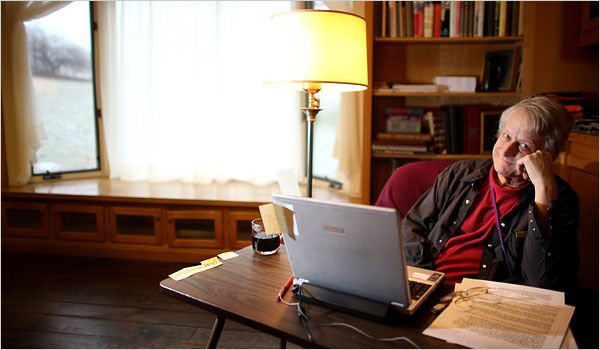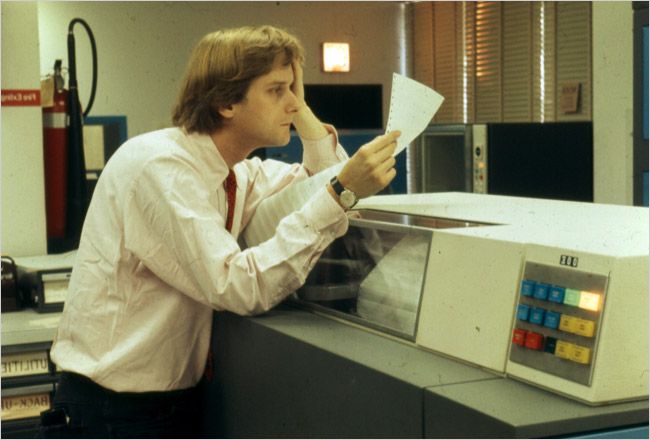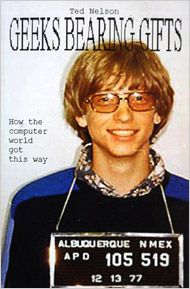
connect the dots.
Ted Nelson: "Gifts from Geeks: How the Computer World Got Here"

Before the personal computer, before the web, Ted Nelson knew nearly half a century ago how computers would change the printed page.
Mr. Nelson, who foresaw and inspired the World Wide Web, coined the term "hypertext", which embodies the idea of linking a web of objects including text, audio and video.
Nielsen, 71, takes stock of the computer world in his new self-published book,Geeks Bearing Gifts: How the Computer World Got This Way . The visionary looks back with bitterness. After all, The Web can be seen as a regression of his original concept that hyperlinks should point both forward and backward.
The inventor of the World Wide Web, Tim Berners-Lee, organized the world's content through the one-way mechanism of Uniform Resource Locators (URLs). Mr Nelson's concept of two-way link, which refers to the content of any two related documents at the same time, is lost in the process, which he argues in vain, preserves the original knowledge of any subject inherited.
One-way links are easily broken, and there is no easy way to maintain authorship and credit, as Nielsen did in the 1960s with a project called the Xanadu project a little. By integrating a micropayment system, he claims, his two-way link might prevent the internet from destroying the economic value of the printed word like a tornado.
A generation of young computer enthusiasts growing up in the 1960s and 1970s was deeply influenced by Mr. Nelson's ideas. In 1974, his book Computer Lib called on people to reinvent the computer.
The book is written in the tradition of the Whole Earth Catalog and serves as a paper-based placeholder for the Xanadu system, which he believes will inevitably Get the upper hand. This book is very interesting. It's actually two books in one: Beginning on opposite covers, can be read back and forth, and the back of the book is titled "Dream Machines: New Freedoms Through Computer Screens - Minority Report ."

The book offers a glimpse into the world heralded by the age of the personal computer, when the personal computer was just invented at Xerox's Palo Alto Research Center. This is the first hint that computing will be more than the "do not bend, fold, spindle or mutilate" control system associated with the mainframe computing era.
We learned that computers would no longer be clunky behemoths controlled by the priestly class—they were something we could get our hands on. They will be fantasy amplifiers and will enhance our pencils, paper and electric typewriters.

Thirty-five years later, the cover of Geeks Bearing Gifts certainly caught the eye.
Bill Gates in the photo is shaggy, wearing glasses and smiling. The photo was reportedly taken in 1977 when Gates was arrested for speeding, a few years after Gates founded his own software company. Like others of his generation, Gates took many of Nielsen's ideas and put them into practice, eventually becoming the world's largest software company.
On the inside cover of Geeks Bearing Gifts, Nielsen asks why Gates is smiling in the photo. The reason, he concluded, was that the young entrepreneur was indifferent to the world, and he already knew the future was bright.
He said his aim was not to discredit Gates. "This is perhaps his most glamorous photo," he said, "exuding sweetness, warmth and confidence."
"You can see what he's doing, though, and the police have no idea what he's up to," Nelson added. "It's only when we look back at this picture that we know what kind of talent he will have."
Nelson was also a pioneer in the computer industry, but he didn't become the richest man in the world.
Despite his unique vision of the future, Nelson remains an outsider in an industry that has brought great wealth to many of his contemporaries.
He is the son of director Ralph Nelson and actress Celeste Holm. He grew up in Greenwich Village, attended college at Swarthmore in the 1950s, and then studied sociology at Harvard with Talcott Parsons.
His unfinished software project Xanadu grew out of his 1960 insight that paper would inevitably be replaced by computer screens. For the next few decades, he continued to work on the project - for a while at Autodesk. More recently, he has lived in Asia and Europe, where his work is generally more appreciated than in the United States.
Last year, he returned to the United States to complete his history. In Geeks Bearing Gifts, he tackles some old problems and writes his own version of the history of computing.
He wrote in a recent email: "I am struck by the blind acceptance of the term 'computer technology' for so long - it sounds so objective and ruthless - when most computer technology is actually A bunch of ideas turned into conventions and packages." (I have long been alarmed by people's sheeplike acceptance of the term 'computer technology' — it sounds so objective and inexorable — when most computer technology is really a bunch of ideas turned into conventions and packages.) He objected to the dominance of "packages" such as Microsoft Office and Windows, arguing that it was an arbitrary result of business practice rather than an inevitable result of technological development.
Some readers might think that Nelson is berating those he sees as money-worshippers who pick and choose to misinterpret his thinking while ignoring his greater ideals. Years later, he was still visibly hurt by a 1995 Wired article (The Curse of Xanadu) that downplayed his quest for Xanadu and suggested This is impractical.
However, there is a danger in the computing world forgetting the past. Indeed, for the complacent computer industry, not only should Nelson's new book be perused, but his recent thinking on software design should also be revisited. They may still point the way forward.
Just look at Nielsen's "Zig-Zag" foray into databases. When I saw it a few years ago, it only seemed to offer an incredibly baroque interface. I didn't realize until recently that he simply foresaw the emergence of the Semantic Web, which is now considered by many computer researchers to be the next step in Internet search. Nielsen also has an interesting redesign of the basic text editor that deserves more attention.
why not? You're already using a very compelling invention, one he calls "tchotchke" and claims he came up with decades ago. It is the back button of the web browser.
Compiled from: A 2009 New York Times article: In Venting, a Computer Visionary Educates by John Markoff and author of Dormouse Says: The Psychedelic Past of the Personal Computer .
Like my work?
Don't forget to support or like, so I know you are with me..
Comment…